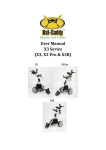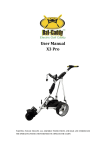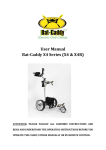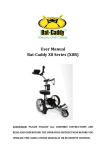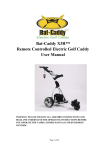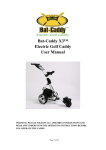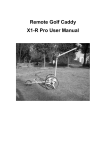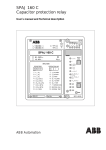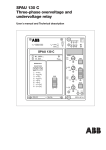Download Bat-caddy X3 PRO User manual
Transcript
User Manual X3 Series (X3, X3 Pro & X3R) X3 X3 Pro X3R ATTENTION: PLEASE FOLLOW ALL ASSEMBLY INSTRUCTIONS AND READ AND UNDERSTAND THE OPERATING INSTRUCTIONS BEFORE YOU OPERATE THE CADDY, EITHER MANUALLY OR BY REMOTE CONTROL. TABLE OF CONTENTS Page Packing List …………..…………………………………………………..……………………………………………2 1. Standard Parts (X3 & X3-Pro)………………………………………………………………………...2 2. Standard Parts (X3R)……………………………………………………………………………………...2 3. Optional Accessories………………………………………………………………………………………2 Parts Glossary………………………………………………………….………………………………………………3 1. X3 & X3-Pro…………………………………………………………………………………………………..3 2. X3R………………………………………………………………………………………………………………..4 Assembly Instructions……………………………………….………………………………………………..…...5 1. X3 & X3-Pro…………………………………………………………………………………………………..5 2. X3R………………………………………………………………………………………………………………..8 Operating Instructions……………………………………………………………………………....................10 1. X3, X3 Pro & X3R……………….……………………………….………………………………………… 10 - T-Handle Control Functions……..……………………………………………………………10 - Additional Functions……………….………………………………………………………………11 - Remote Control Instructions (X3R Only)…………………………………………………..13 Maintenance & Additional Instructions…………….…………………………………………………14 1. Battery Charging and Maintenance…………….………………………………………………….14 2. Testing Your Caddy……………………………………………………………………………………….15 3. Recommendations for Efficient and Safe Operation………………………………………..16 4. General Maintenance……………………………………………………………………………………17 5. Electronic Systems………….…………………………………………………………………………….17 Technical Specifications………………..……..…...…………………………………….................................19 1. X3 & X3 Pro………………………………………………………………………………………………..19 2. X3R….…………………………………………………………………...……………………………………20 Troubleshooting Guide………..………..………….….………………………………………………………22 Frequently Asked Questions (FAQs)………..……………………………………………………….…23 1 PACKING LIST 1. Standard Parts (X3 & X3 Pro) 1 Caddy Frame 2 Rear Wheels (Left & Right) 1 Battery Pack (Lead Acid or Lithium Battery, Bag, Leads) 1 Charger 1 Tool Kit 1 User Manual, Warranty, Terms & Conditions 2. Standard Parts (X3R) 1 Caddy Frame 1 Anti-Tip Wheel & Pin 2 Rear Wheels 1 Battery Pack (Lead Acid or Lithium Battery, Bag, Leads) 1 Charger 1 Tool Kit 1 Remote Control (needs 2 AAA Batteries) 1 User Manual, Warranty, Terms & Conditions 3. Optional Accessories (X3, X3 Pro, X3R) 1 Scorecard Holder 1 Cup Holder 1 Umbrella Holder 1 Seat Cushion, Stand, & Hardware 1 Carry Case NOTE: This device complies with part 15 of the FCC Rules and with Industry Canada license‐exempt RSS standard(s). Operation is subject to the following two conditions: (1) This device may not cause harmful interference, and (2) this device must accept any interference received, including interference that may cause undesired operation. NOTE: THE MANUFACTURER IS NOT RESPONSIBLE FOR ANY RADIO OR TV INTERFERENCE CAUSED BY UNAUTHORIZED MODIFICATIONS TO THIS EQUIPMENT SUCH MODIFICATIONS COULD VOID THE USER’S AUTHORITY TO OPERATE THE EQUIPMENT Bat-Caddy X3R FCC ID: QSQ GC827322 IC ID: 10716A 2 PARTS GLOSSARY 1. X3 & X3 Pro 1. 2. 3. 4. T-Handle with Control Face Faceplate and Manual Speed Control Upper Bag Support Upper Bag Support Bungee Pigtails Battery with Leads and Carrying Case (12V Sealed Lead Acid or Lithium Deep Cycle) 5. Rear Wheels (Left & Right) 6. Wheel Hub with Locking Mechanism 7. Rear Wheel Rubber Tread 8. Battery Tray with Plug Receptacle 9. Lower Bag Support and Fender with Support Strap and Tracking Adjustment Mechanism 10. Front Wheel 11. Frame Locking Hinge (2 locks on X3 Pro) 12. 110-240V Charger 3 2. X3R 1. 2. 3. 4. T-Handle with Control Face Faceplate and Manual Speed Control Upper Bag Support Upper Bag Support Bungee Pigtails Battery with Leads and Carrying Case a) (12V 34/35Ah Sealed Lead Acid Deep Cycle) 5. 2 Identical Rear Wheels 6. Wheel Hub with Locking Mechanism 7. Rear Wheel Rubber Tread 8. Battery Tray with Plug Receptacle 9. Lower Bag Support and Fender with Support Strap and Tracking Adjustment Mechanism 10. Front Wheel 11. Frame Locking Hinge 12. 110-240V Charger 13. Remote Control Handset 14. Anti-tip Wheel with Pin (not shown) 15. Dual Motors and Gearboxes (not shown) 4 ASSEMBLY INSTRUCTIONS 1. X3/X3 Pro 1. Unpack all items carefully and check inventory. 2. Place frame structure (one piece) on soft and clean ground to protect frame from being scratched. Erect frame by unfolding and connecting the main frame tube together at the joint and locking the Y-shape lower support structure to the main frame with the frame lock mechanism. a. X3 5 X3 Pro 3. Attach wheels to axles by pushing wheel locking button on the wheel hub and inserting the axle extension into the wheel. Make sure to keep the locking button on wheel hub pushed in during this process, in order to enable the axle extensions to be inserted all the way into the wheel so the axle sprocket locks into the hub. If not locked in, the wheel will not be connected to the clutch and will not be propelled or come off! Test the lock by trying to pull the wheel out. To disassemble the wheels, proceed in reverse order. Attention: Make sure that the right wheel (marked R) is attached to the right side and the left wheel (marked L) to the left side (seen from behind in driving direction), as the wheels have built-in one way clutches. The caddy will not move if the wheels are not on the proper side. Reverse the action to remove the wheels. 6 4. Place battery pack on battery tray and fasten Velcro strap around battery tightly. Insert 3 prong battery plug into caddy outlet so notch aligns properly with plug. It is recommended NOT to fasten the screw on the plug to the outlet, so in case of tip over the cable can unplug from the socket. Note: Before connecting make sure that Rheostat Speed Control on handle is in OFF position! 5. Install optional accessories, such as Scorecard/Beverage/Umbrella holder, below handle in the foreseen places or receptors. Instructions provided separately. 7 2. X3R 1. Unpack all items carefully and check parts inventory. 2. Place frame structure (one piece) on soft and clean ground to protect frame from being scratched. Attach wheels to axles by pushing wheel locking button on the wheel hub and inserting the axle extension into the wheel. Make sure to keep the locking button on the wheel hub pushed in during this process, in order to enable the axle extensions to be inserted all the way into the wheel. If not locked in, the wheel will not be connected to the clutch and will not be propelled or will fall off! Test the lock by trying to pull the wheel out. To disassemble the wheels proceed in reverse order. 3. Erect Frame by unfolding and connecting the main frame tube together at the joint and locking the Y-shape lower support structure to the main frame with the frame lock mechanism. Proceed in reverse for folding the caddy. 8 6. Place the battery pack on the battery tray and fasten the Velcro strap around the battery tightly. Insert the 3-prong battery plug into the caddy outlet so the notch aligns properly. It is recommended NOT to fasten the screw on the plug to the outlet, so in case of tip over the cable can unplug from the socket. Note: Before connecting, make sure that the Rheostat Controller is in OFF (0) position, and the remote control is stored securely! 4. Insert Anti-tip Wheel into frame holding bar and secure with pin. 7. Install optional accessories, such as Scorecard/Beverage/Umbrella holder, below handle in the foreseen places or receptors. Separate instructions provided. 5. Unpack remote control and install batteries with plus and minus poles as indicated in the diagram in the receiver compartment of the unit. Now you are ready to learn and understand the functions of the manual and remote controls. 9 OPERATING INSTRUCTIONS 1. X3, X3 Pro & X3R Handle Controls Display screen Speed Control 1. Timed Distance Advance Function : Press once, display will show A , the caddy will run ca. 10 Yards/Meters and stop Press twice, display will show B , the caddy will run ca. 20 Yards/Meters and stop Press three times, display will show C , the caddy will run ca. 30 Yards/Meters and stop ATTENTION: do not use these functions when the caddy is close to water or other hazards! 2. Power Switch & Cruise Control/Go/Stop Function: 1. ON/OFF Button: controls the caddy’s power supply. Press for ca. 3-5 seconds in order to switch the caddy ON or OFF (similar to a mobile phone operation) 2. Go/Stop Button. Press once and the caddy will stop, press again trolley will start at the same speed. Timer and Go/Stop button: when trolley goes at 1-5 speed level, start Timer function and press go/stop , this will cancel the Timer function , display will go back to previous speed level, press again and the caddy will go in former speed level. 3. Speed Control Scrolling of the speed button clockwise/forward lets you choose your preferred speed to suit your pace, and the display will show the preferred speed. The speed level goes from 1 to 5. 10 4. USB plug (optional) located under handle cover for GPS or cell phone. Additional Functions Tracking Adjustment; tracking behavior of all electric caddies is strongly dependent on equal weight distribution on the caddy and slope/topography of the golf course. Test your caddy’s tracking behavior by operating it on an even surface without the bag. If changes are necessary, you can adjust the tracking of your caddy by loosening the front wheel axle and shifting the front wheel as needed. After adjustment, fasten screws in reverse order. Note: Don’t over tighten the nuts. 11 Installation of Seat Attach seat holding bar to caddy frame Attach seat stand to seat bottom using the four small screws. Attention: Attach in such manner that the seat is parallel to the driving direction of the caddy, with the opening facing the outside when you slide it into the holding bar. Slide seat stand into holding bar as shown. Due to the spring mechanism, the seat should reach the ground when pushed down, so the weight rests solely on the ground. Note: DO NOT attempt to sit on the seat while trying to move the caddy, or frame damage might occur! Test caddy power supply by pressing On/Off button for 2-5 seconds. All control lights should come on and the caddy should be operable by both the manual control on the handle and the remote control. Note: Familiarize yourself with the handle and remote control functions (X3R only) BEFORE you start operating the caddy. Practice in a wide area free of obstacles, people or any other danger. 12 Remote Control Instructions (X3R Only) Functions: A. Brake: The red STOP button in the middle of the directional arrows should be used for stopping the caddy. B. Timer: 10, 20, 30 yards/meters C. Backward Arrow: Pressing the back arrow will set the caddy in backward motion. Increase backward speed by pushing multiple times. Press also to decrease forward speed/slow down the caddy D. Forward Arrow: Pushing the forward arrow will set the caddy in forward motion. Pushing multiple times will increase the speed. E. Left Arrow: initiates left turns. When the arrows are released the caddy stops turning and continues straight with the original speed prior to turning. F. Right Arrow: same as left arrow function. G. On/Off Switch: On right side of device turns remote control on or off; recommended to prevent accidental engagement of caddy H. Antenna: internal I. Batteries: 2 x 1.5V AAA Important Notes – PLEASE READ CAREFULLY - Change the remote control batteries once the indicator LED gets weak - The remote control uses two 1.5V AAA batteries available in any supermarket, drug store, or electronics store - It is recommended to keep a set of extra batteries ready as replacement - To change the batteries, open up the battery compartment cover by pulling the lever and place the batteries according to the diagram in the battery compartment - The remote control system is designed to not interfere with other electric caddies - The maximum range of the remote control varies between 80-100 yards, depending on the battery charge, obstacles, atmospheric conditions, power lines, cell phone towers, other electronic/natural interference sources - It is strongly recommended to operate the caddy at a maximum range not exceeding 20 yards in order to prevent the loss of control of the unit! 13 MAINTENANCE & ADDITIONAL INSTRUCTIONS 1. Battery Charging and Maintenance (see specific separate instructions for sealed lead acid (SLA) and lithium batteries) - - - PLEASE OBEY THESE PRECAUTIONS FOR BATTERY USE & CHARGING: Please do not charge the battery in a sealed container or in upside down position. It is recommended to charge the battery in a well ventilated area. Please do not charge the battery near a heater, where heat accumulation may occur, or in direct sunshine. In order to prolong the service life of the battery, please avoid complete discharge and charge the battery after every use. Unplug the battery from the charger once the charge is complete. When the trolley is not in use for an extended period of time, it is recommended to charge the battery once a month. The battery’s poles’ red color stands for positive, and the black for negative. In case of battery replacement please reconnect the poles of the battery correctly; otherwise your caddy could suffer severe damage. Please do not disassemble the battery or throw it into a fire; this will cause an EXPLOSION! NEVER TOUCH THE ELECTRIC POLES OF THE BATTERY! THIS IS A SEVERE SAFETY HAZARD! Battery Charging Instructions SLA Batteries: Connect the battery cable plug with the charger and then plug the charger into an electrical outlet. During the charging cycle the LED on the charger will show a red steady light. Once the charging cycle is complete the red light, will turn into a steady green light. It is now okay to unplug the charger and battery for reuse. The charging cycle can last up to 12 hours depending on the level of discharge. Normally the battery will hold its charge for several months, and it does not have a “memory effect”, and therefore can be recharged at any discharge level. It is not recommended to fully discharge the batteries, as this will shorten battery life drastically. The battery has a normal lifespan of approx. 150 charges, depending on charging frequency, storage conditions, and time and discharge history, which could reduce this lifetime. Before storing a battery for extended periods of time you must fully charge it. DO NOT store a discharged battery or else it might become unusable. Replacement batteries are available from your authorized dealer or directly from Bat-Caddy. Recommendations - Fully charge the battery for ca. 12 hours before the first use - Do not leave the battery on the charger if it is not used for extended periods of time; remove it from the charger after charge is complete - The battery will take approximately 2-3 rounds and charging cycles before it reaches its full operating potential. During the first couple of rounds it might still 14 - be below its optimal power. Always keep your battery fully charged before another game Never keep your battery connected to the grid during prolonged power outages. It might be irreversibly damaged. Do not fully discharge the battery by “overplaying” it. It is recommended to recharge the battery after every 18 holes. *Life of sealed lead acid and any other batteries is dependent on a variety of factors, other than purely the number of charges, including but not limited to frequency between charges, duration of charge, level of drainage, idle time, storage conditions and duration and overall shelf time. We cover our batteries according to our warranty policy and any potential additional coverage is at our discretion. 2. Testing Your Caddy Test Environment First, make sure that you perform your first test of the caddy in a wide and safe area, free of obstructions or valuables, such as people, parked automobiles, flowing traffic, furniture or water bodies (rivers, swimming pools etc.), steep hills, cliffs or similar hazards. Manual Control Operation Test the manual function first: Press the On/Off button for 2-5 seconds. The manual functions of the caddy are controlled through the rheostat control wheel on the top of the handle. Pushing the wheel clockwise will control the forward movement of the caddy. In order to slow down or stop the caddy, turn the wheel counterclockwise. Remote Control Operation (X3R Only) Make sure you are close to the caddy at all times while testing it and familiarizing yourself with the remote control! Now turn on the main power switch and make sure that the rheostat control wheel is in OFF position. One touch of the Forward/Backward arrows on the remote control starts the caddy in either direction. Further pushes increase the speed. In order to stop the caddy press round red STOP button in the middle of the remote! To turn the caddy in either direction push the left or right arrows briefly. Once you release the button the caddy will continue in the current direction at the same speed prior to the turning command. You will notice that the caddy reacts promptly to any turning command, so it will take you some practice to get just the right touch for turning maneuvers. Please be aware that the turning characteristics will change depending on the surface (grass, asphalt), the slope or the weight (loaded, unloaded) of your caddy. The remote is designed to have a reach of approximately 80-100 yards, but we strongly recommend to operate the caddy in closer ranges of 10-30 yards (not exceeding 50 yards) to be able to react to any unforeseen events, such as other golfers crossing your path or to avoid hidden obstructions (creeks, bunkers, GUR, etc.) or an unexpected disconnection 15 in remote operation. An additional safety feature of this caddy is that it will stop moving if it does not receive a signal from the remote control at least every 45 seconds. This way, should you ever be distracted, your caddy does not completely get away. By pressing the lower Timer button on the remote the caddy can be moved forward automatically by 10, 20, or 30 yards. STOP will make the caddy stop in case of overreach. Do not use this function close to water or other hazards. 3. Recommendations for Efficient and Safe Operation - Be alert and act responsibly at all times while operating your caddy, just as you would when operating a riding cart, motor vehicle, or any other type of machinery. We absolutely do not recommend the consumption of alcohol or any other impairing substances while operating our caddies. - Do not operate the caddy carelessly in narrow or dangerous spaces, places with valuables or any people gathering areas, such as parking lots, close to flowing traffic, bag drop-off areas, stores, driving ranges, putting greens and practice areas, pro shops, restaurants, starter areas and other areas where people or items could be harmed through an error or lack of skill in operation. In such situations the caddy should be best operated manually with or without power. Also, please make sure to always switch off the power and secure the caddy when you park and leave the unit for any reason, either on or off course. - With its optimized balance and straight front wheel, the caddy has extraordinarily narrow and responsive turning and maneuvering abilities. However, it sometimes tends to react to uneven weight distribution of its load or slope variations and will follow the weight and the slope of the golf course, which is normal for electric caddies. Therefore, please make sure that the weight in your bag is distributed evenly (move heavy balls and items to both sides equally and to the upper part of your bag, or shift the bag on the caddy). Also, when operating your caddy, anticipate the slope of the course in order to avoid frequent corrections in direction. In some extreme environments, such as very uneven terrain, steep hills, narrow and/or sloped cart paths, muddy areas, gravel paths, close to bunkers and hazard, around bushes and trees it is strongly recommended to operate the caddy via manual control in order to prevent any collisions, damage or the need for complicated correction adjustment maneuvers. When operating the caddy often in bumpy terrain we recommend to add an additional bungee strap to the lower and/or upper bag support to give the golf bag additional hold and prevent it from shifting. - Please avoid or minimize operation on hard and rough surfaces, such as cart paths, asphalt roads, gravel roads, roots etc., as this will cause unnecessary wear and tear on tires, wheels and other components. Bumping into hard objects might cause damage! The caddy is best operated on soft and smooth surfaces such as fairways. 16 4. General Maintenance The steps below will ensure that you get a prolonged and reliable life out of your Bat-Caddy. - The Caddy has been designed so that the user can concentrate on playing golf, while the caddy does the work of carrying your bag. In order to keep your Bat-Caddy looking its best, we advise that you wipe any mud or grass from the frame, wheels and chassis after every round with a damp cloth or paper towel. - NEVER use water hoses or high-pressure jet washers to prevent moisture entering the electronic systems, motors, or gear boxes of the caddy. - Remove the rear wheels every few weeks and clean out any debris that might cause the wheels to drag. You might also consider applying some lubricant, such WD-40, to keep moving parts smooth and corrosion-free. - A 4-5 hour round of golf played once a week for 12 months is equivalent to ca. four years’ use of a lawn mower, so please thoroughly inspect your cart at least once a year, and if you notice any symptoms of wear, contact your Bat-Caddy Service Center. Alternatively, you can have your caddy inspected and tuned by our Service Center, so it’s always in great shape for the new season. - Always disconnect the battery when you store the caddy, and always put your caddy together before re-connecting the battery. If you are not planning to play for at least a month, store the battery in a cool and dry place (not on concrete floor) and don’t leave it on the charger. All of these recommendations and common sense will help keep your Bat-Caddy in top condition and ensure that it remains your reliable partner, both on and off the links. 5. Electronic Systems - Remote Control Range: We recommend not to exceed 20-30 yards distance. The greater the distance between you and caddy, the greater the chance of losing contact with it - Microcomputer: The remote caddy has 3 microcomputer controls: The first is in main controller box. The second is in the remote control transmitter handset, and the third is in the receiver in the handle. - Safety Protection: When the temperature of the controller box reaches its upper limit in case of an overload it will automatically shut down to cool off. 17 - Microprocessor Controlled Electronics System: When you connect the battery, the electronics system will automatically run through a start-up routine. Then you can press the main OFF/ON switch on the handle. The battery charge indicator lights will show you the charge level of the battery from green (fully charged) to red (discharged). - Important: The electronics controller box contains no user serviceable parts. Therefore, it is sealed to reduce the risk of moisture entering and impacting the electronic system. Breaking this seal increases the risk of damaging the electronics and decreasing the reliability of your caddy. DO NOT attempt to open the controller case. Doing so will void the warranty! - Battery Operation and Care: Follow battery charge and maintenance instructions. The battery comes with leads and a 3-prong connector. Note: Bat-Caddy reserves the right to modify/upgrade any components during a model year, so illustrations on our website, brochures and manuals may slightly vary from the actual product shipped. However, Bat-Caddy guarantees that specifications and functionality will be always equal or better from the advertised product. Promotional accessories may also vary from illustrations shown on our website and other publications. 18 TECHNICAL SPECIFICATIONS 1. X3 & X3 Pro Model Name X3 Standard Battery 33Ah SLA Dimensions SLA: 8 x 5 x 6 in (20 x 13 x 15 cm) Weight: 20 Lbs Average charge time: 4-8 hours Lifetime: ca. 150 charges Standard Battery Duration 27-36 holes 35Ah SLA @ $25.00 Battery Upgrade Options 20Ah Lithium @ $400.00 Folded Dimensions Length: 34” (86 cm) Width: 20-21” (51 cm) Height: 16-17” (41 cm) Unfolded Dimensions Length: 46/48” (117 cm) Width: 20/21.5” (51 cm) Height: 39” (99 cm) Weight Caddy 18.7/20.7 lbs (8.5/9.4 kg) Weight Standard Battery 20 lbs (9 kg) Total Weight 39 lbs (17.7 kg) (standard battery) Speed 5.4 mi/h (8.6 km/h) Control Functions Manual Seamless Rheostat Cruise Control/Stop/Go Functions: Forward, Stop Timed Advance function (10,20,30 M/Y) Power Switch Speed Indicator USB Port (optional) Distance/Range 15 mi (25 km)/27-36 holes Climbing Ability 30 degrees Off-Power Free-Wheeling Mode Maximum Load 66 lbs (30 kg) Charger Input: 110-240V AC Output: 12V/2A-3A Trickle Charger Motor Power: 1 x 200 Watt (200 Watt) 12V DC Electric Front Wheels Airless, rubberized tread Tracking adjustment 19 Rear Wheels Airless, rubberized tread Quick-release mechanism Drive Train Rear Wheel Drive Gear ratio (17:1) Handle Height Adjustment N/A Materials Aluminum/SS and ABS Available Colors Iridium Silver, Black, White Complimentary Accessories Scorecard Holder (depending on promotions) Cup Holder Umbrella Holder Carrying Bag Seat Optional Accessories Rain Cover Sand Dispenser GPS Holder see "Special Offers" Introduced (year) 2009/2012 Warranty 1 Year on Parts and Labor 1 Year on Battery X3R Model Name X3R Standard Battery 34/36Ah SLA Dimensions: 8 x 5 x 6 in (20 x 13 x 15 cm) Average charge time: 4-8 hours Lifetime: ca. 150 charges Standard Battery Duration 27+ holes Battery Upgrade Options Lithium @ $400.00 Folded Dimensions Length: 32 in (82 cm) Width: 24.5 in (61 cm) Height: 12 in (30.5 cm) Unfolded Dimensions Length: 43 in (109 cm) Width: 24 in (61 cm) Height: 39 in (99 cm) Weight Caddy 24 lbs (10.9 kg) Weight Standard Battery 25 lbs (11 kg) Total Weight (standard battery) 49 lbs (22 kg) Speed 5.4 mi/h (8.6 km/h) Control Functions Manual Seamless Rheostat Remote Control (range up to 80-120 yards) Functions: Forward, Reverse, Left, Right, Stop 20 Timed forward advance function (10,20,30 yards) Cruise Control Power On/Off USB Port (optional) Distance/Range 13 mi(20 km)/27+ holes Climbing Ability 30 degrees Off-Power Free-Wheeling Mode Maximum Load 77 lbs (35 kg) Charger Input: 110-240V AC Output: 12V/3A-4A Trickle Charger Motor Power: 2 x 200 Watt (400 Watt) 12V DC Electric Front Wheels Airless, rubberized tread Tracking adjustment Rear Wheels Airless, rubberized tread Quick-release mechanism Anti-tip wheel assembly Drive Train Rear Wheel Drive Dual independent transmission Gear ratio (17:1) Handle Height Adjustment N/A Materials Aluminum/SS and ABS Available Colors Iridium Silver, Black, White Complimentary Accessories Scorecard Holder (depending on promotions) Cup Holder Umbrella Holder Carrying Bag Seat Optional Accessories Rain Cover Sand Dispenser GPS Holder see "Special Offers" Introduced (year) 2006 Warranty 1 Year on Parts and Labor 1 Year on Battery 21 TROUBLESHOOTING GUIDE Symptom Caddy does not have power Motor is running but wheels don’t turn Caddy pulls to left or right Battery/Caddy lacks power Problems attaching wheels Action - Check all wiring connections and plugs - Check battery charge/ - Check On/Off button/switch - Check if wheels are secured to axle by split pin - Check right and left wheel position on X3/X3 Pro - Check right/left wheel clutches - Check if wheel is fitted over clutch & latched to axle - Check if axle pin is visible at both sides of axle - Check clutch: turn freely in one direction only - Check tracking on level ground - Check weight distribution in golf bag - Check cable connections - Check battery charge - Check charger function - Adjust quick release catch 22 FREQUENTLY ASKED QUESTIONS (FAQs) Please check our website at http://batcaddy.com/pages/FAQs.html for FAQs For Technical Support please contact one of our Service Centers. Contact info at http://batcaddy.com/pages/Contact-Us.html Check our website www.batcaddy.com Bat-Caddy is a registered trademark of SpaCom LLC 23
























